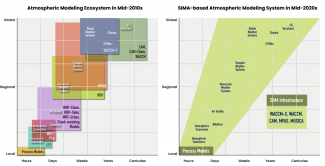The System for Integrated Modeling of the Atmosphere (SIMA) project aims to unify existing NCAR community atmosphere modeling efforts across weather, climate, chemistry, and geospace research. NCAR scientists, in partnership with the atmospheric and geospace sciences research community, are developing a SIMA framework and infrastructure that enables simulations of atmospheric processes and atmospheric interactions with other components of the coupled Earth system ranging from the surface to the ionosphere, and across scales from cloud-resolving weather to decadal climate studies. One of SIMA’s goals is to enhance atmospheric and earth-system modeling applications for frontier-science problems. An example is the sub-seasonal to seasonal predictability of tropical cyclone formation, which requires the capability to represent convective-permitting scales over the tropics coupled to an Earth System Model (ESM). This can extend to investigating the role of aerosols on tropical cyclone formation. Another frontier-science application is quantifying the impact of biomass burning on air quality, atmospheric chemistry, and weather from local to global scales. This requires the capability to represent fires on convective-permitting scales and detailed chemistry and aerosol processes. Additional frontier science application examples are described in the SIMA Vision document.
SIMA will allow NCAR to shift from using a complex modeling ecosystem composed of several atmosphere models, each with their own specific application (e.g., Weather Research and Forecasting (WRF) and Model for Prediction Across Scales (MPAS) standalone atmosphere models for weather research, Community Atmosphere Model (CAM) for climate research, Whole Atmosphere Community Climate Model eXtension (WACCM-X) for thermosphere and ionosphere research) into a single modeling system that can be configured for a range of applications (Figure 1). In November 2021, SIMA version 1 was released to the community. This initial version of SIMA includes development of a CAM configuration that contains regionally-refined grids over the Arctic and Greenland and development of high-resolution capability of WACCM-X and one-way coupling between WACCM-X and a geomagnetic grid mesh for magnetohydrodynamics calculations. For SIMA v1, atmospheric chemistry input, emissions data, and chemistry code have been modified to be compatible with unstructured grid meshes and regional refinement of grids. Atmospheric chemistry simulation output for a CAM configuration with regional refinement over the contiguous US was made available via the Geoscience Data Exchange site. A model-independent chemistry module, which enhances the flexibility of prescribing the chemical constituents and reactions, was released in a box model configuration for testing and classroom teaching.










